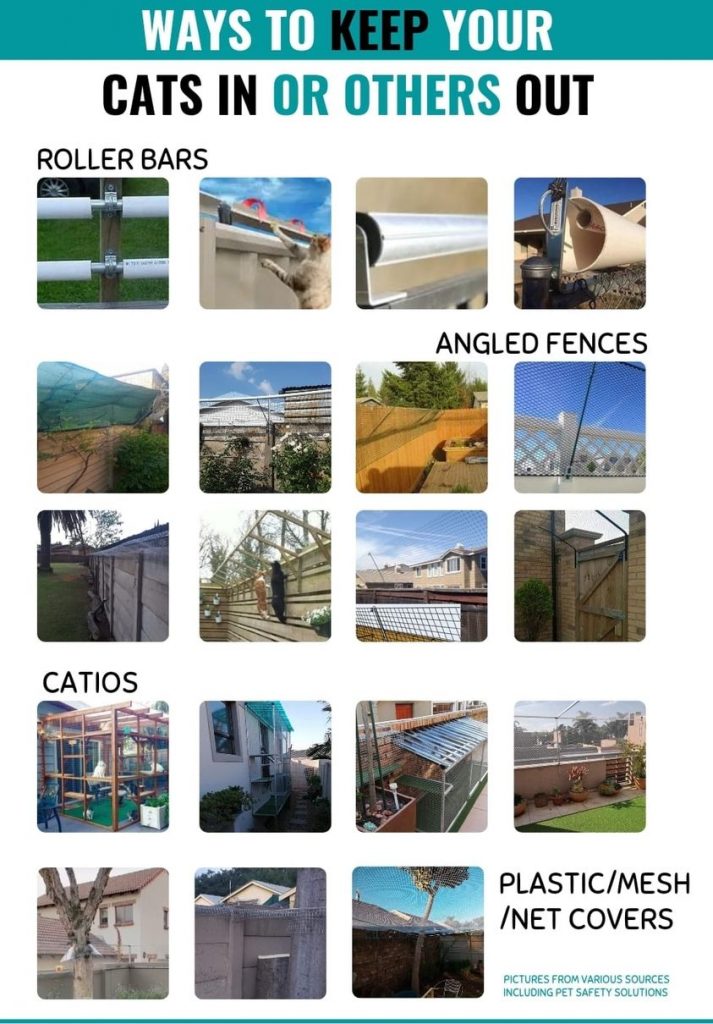
THERE ARE MANY CREATIVE WAYS TO KEEP YOUR CAT SAFE IN YOUR YARD.
Why do you think we advocate for keeping ALL animals, including cats, safe in your yard? We live in a cruel, unforgiving and sick world. If you are on social media, follow the news, or just use Google, you should by now have been wholly terrified by the atrocities being committed against animals. If you think the streets are not safe for your kids, why would you let your pets roam the streets?
Unfortunately, living outdoors comes with a pretty serious set of risks for our furry family. Dangers like, vehicle & traffic, predators (both animal and human), snares, attacks by other animals and poisons are all common encounters that pets face outdoors. Most people will not poison or shoot your kids, but many have no problem doing it to cats or other animals.
By keeping your pets inside, you extend their life span, save on potential vet bills and have peace of mind, in addition to the fact that you are responsible for them! The average life expectancy of an outdoor cat (that is one that lives outdoors) is just two to five years, compared to an indoor-only cat whose averages is around 15 years. For indoor/outdoor cats the average life expectancy would be somewhere in between.
Building an enclosure or securing your garden will protect your cat from the many dangers associated with roaming.
WHY IS IT DANGEROUS FOR YOUR CATS TO ROAM?
- You can prevent your cat from getting lost or stolen. The fact is that cats are getting lost or stolen or injured or killed and the most common causes of premature death are preventable! Less cats are microchipped and people take much longer before they start searching for their missing cats. Most people assume the roaming cat lives nearby and then these animals are not reported. Males can walk kilometers far after a female in heat. Animal thefts are also on the rise and cats are also being used as “bait” in dog fights.
- You can be a better neighbour. Cats easily become a nuisance for others as they go into people’s yards or homes. They cause stress for that home’s pets or eat their food. The mating and spraying rituals also become a nuisance and then sadly people shoot or poison these cats. The bullets rarely if ever, kill them, so they are paralyzed when lodged in the spine or they can bleed to death, etc.
- Cats have not attended traffic school and are not as familiar with traffic rules as you are. You may think that your kitty is street-savvy but be assured they can just as easily be a victim. They can also be distracted, chasing something, or be chased and then get hit by a car. There are frequent “hit by a car” situations we see as we drive around. Even if they do survive the vet bills can be high and the recovery or suffering can be hard and long.
- Close to fields, cattle herders and others set traps/snares for rabbits or other sources of food. We have seen many kitties trapped, hurt and dying of what can olnly be an agonizing death, in these traps.
- Poisons are another danger outdoor cats are exposed to. On a daily basis, your cat can encounter poisonous chemicals like insecticides, rodenticides, and fertilizers. Pesticides are the most dangerous because they are sweetened or scented to attract pests and other animals are often the unintended victims. This can include but is not limited to, lawn fertilizer, snail bait, rat poison, ant bait, antifreeze and even fresh paint.
- When cats are frightened or during heavy or cold weather, they sometimes find shelter in car engines and you do not want to hear the horror stories we can share on this. Cats won’t get trapped in sheds and garages or other car engines or jump into vehicles if they are safe in your yard.
- Cats are territorial and get into fights. Preventing them from roaming reduces the risk of injury from fighting with other cats. Worse than cat bites are the viral infections that go along with it. Feline Aids (FIV), Feline Leukemia (FeLV), and on rare occasions rabies, to name but a few. Some diseases are spread by close contact alone, including Feline Leukemia (FeLV) and Feline Infectious Peritonitis (FIP).
- Protect your cat from injuries from being attacked by other animals or animal abusers. Your cat may be a predator, but can also be the prey. Depending on the area you live in, cats can easily fall prey to bigger and stronger predators.
- Unfortunately, many pets who are allowed to roam are not sterilized. Cats can have 3 litters of 4-6 kittens a year from as young as 4 months. You do the maths. Unsterilized and roaming kitties add to the massive overpopulation crisis we face. You will either end up with kittens or cause others to have kittens because your cat was not sterilized.
- Parasites, such as worms, fleas, and ticks are another danger outdoor kitties are exposed to. They also bring them home and expose your family or other animals to these parasites. Especially unvaccinated kittens should be kept indoors until they have been vaccinated.
- Believe it or not, witches are living among us. We recently had local cases of animals involved in witchcraft, especially cats. It is not just black cats that are at risk for this. Do you want your pet to suffer and be slaughtered as an offering?
- Non-breakaway collars cause cats to get stuck in dangerous situations, so please choose breakaway collars with tags.
HOW TO PREVENT YOUR CAT FROM LEAVING THE YARD.
Now that we have looked at the “why”, let us look at the “how”. We will explore some practical ideas to “cat proof” your property, and keep your cat safe
FENCE YOUR YARD
Yes, it can be done. I have found some very practical ideas on Google and Pet Safety Solutions, to demonstrate this point. Even if you start with just a portion of your yard fenced off, for your kitty, it will be safer than letting them roam freely.
- Ideas range from high walls (above 6ft), with pet-safe electric fencing on top. If needed, raise your fence.
- Attach rotating pipes, gutter pipes, or spinning paddles to existing walls.
- Angled fencing on top of an existing wall, is just as effective and can also be done by yourself.
- Small plastic spikes, can be fastened to the top of the wall, and won’t hurt the cat, but might deter it from jumping.
BUILD A CATIO
A catio can be made of metal, wood, or any other durable material. Just make sure the materials used are non-toxic and free from sharp edges. It can be attached to your house, with access through a window or cat flap, or a separate enclosure on the property.
A Catio can be a simple window box, or a large enclosure, with, or without grass, or a small box with grass. Wheatgrass purchased in the veggie department of your local supermarket, makes a safe alternative to grass, for cats to nibble on. You can put cat furniture, litterboxes and other items in the catio, to keep it interesting for your cat.

OTHER METHODS
- Together with fences you can plant certain species of plants that cats dislike, however you need to make sure it is not poisonous to them. Some cats seem to dislike the smell of rue, lavender, pennyroyal, coleus Canina and lemon thyme. Some cats also seem to not like strong citrus cents and some sources suggest human hair smell as well.
- Trees can be trimmed regularly and wrapped in plastic or PVC “dividers” so that they cannot be climbed and still allow your kitty access to the outside.
- If you really cannot apply any of the above (which is doubtful), try creating a routine for your cat. For example, a lick of wet food in the morning to make sure they check in and again in the evening. Once they are in for the evening, close them in until the morning. Yes, you can do it and your kitty will not be harmed.
- Create entertainment for your cats, toys, boxes, and scratchies to amuse them. Use catnip. Cats are crepuscular and are most active at dusk and dawn anyway. Most cats will adapt to living indoors. If your cat has difficulty adjusting, start by gradually increasing the time they spend indoors. Start with a part of the evening and gradually increasing the time.
- Last but not least, invest in a good quality cat harness. Acclimatize your cat to the harness from a young age. With patience and persistence, older cats will also get used to it.
- There are “invisible” fence methods, but due to the sensation or sound it creates if the cat comes near (while wearing a particular collar), we would not support it!
The same way you keep your cats in, you can keep other cats out if you don’t want them in your yard. Please sterilize, microchip, deworm, vaccinate, treat for ticks/fleas and keep them safe in your yard while providing enough enrichment. Please report cruelty to cats which includes any poisoning or shootings. Remember to register your microchip on multiple databases! Always remember that an animal that appears to be a nuisance, somewhere has a human who failed them. Blame the human, not the animal.
Also read how to escape-proof your yard for dogs and why “free to good home” ads are bad idea. For assistance with escape-proofing your yard, you can contact Pet Safety Solutions. We have not worked with them directly and this is not a paid endorsement, but we frequently see their posts and creative ideas and they may come to your town.
By now you will realize the point is that your kitty does not need to roam outdoors to be happy. Provide for their basic needs at home, and they can live longer and healthier lives when safely confined. You do not need to spend lots of money to keep your cat safe, but can you put a price on safety?
Next week we will look at whether you dress to kill or kill to dress.
WHEN YOU KNOW BETTER, DO BETTER!